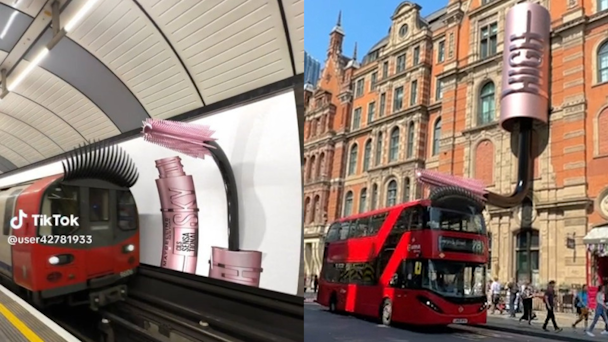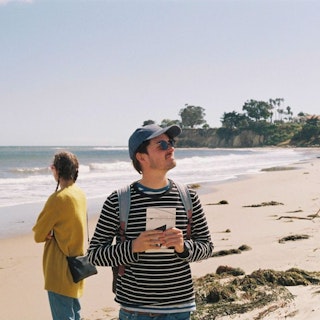Do ads have to be real? Marketing execs weigh in on viral tricks and fakes
First Maybelline’s ‘fake’ giant mascara wand, then Orange’s World Cup AI fake-out. Not-quite-real ads are here, and deepfakes aren’t far behind. Should advertisers be wary? We asked The Drum Network.

Should ads always be 'real'? Or is a bit of fun fakery harmless?
Sarah Jenkins, partner and executive vice president, The Romans New York: “As creative marketers, we’re in the business of imagination. We develop brand campaigns based on insights that strike a chord with aspects of consumers’ personalities (often a playful side): ideas that push us to think beyond what’s possible. We should never, ever limit ourselves to traditional reality, because that would stifle the curiosity that’s critical for creative evolution.
“When you’re working on a campaign that has potential negative impact, you have a responsibility to disclose when things are generated by AI. But let’s not hold back from exploring the what-ifs. Consumers of all ages are craving levity; often, that comes from the powerful escapism of make-believe. Just proceed with caution, consider negative impact, and act in a way that doesn’t pose risk to individuals or groups.”
Henry Challender, associate creative director, Bray Leino: “Realness is blurry. Neither physicist nor philosopher can tell you what reality ‘really’ is. Some people (hey Elon) even contend it’s all a big simulation. But before we get into a metaphysical pickle, let’s agree on the everyday distinction between ‘real’ (genuine, authentic, true) and ‘fake’ (false, deceitful, artificial). On those terms, it’s hard to claim marketing’s ever real. Artifice is almost always baked into the deal. Are we being ‘real’ when pricing something 99p rather than £1? When we retouch that burger?
“Even the worthiest purpose-led campaign may be tinged with an ulterior motive. AI brings new toys for tricksters, making it easier to be wilfully deceptive. As the line between the real and the fake gets blurrier, perhaps transparency will set the good actors apart from the bad. But maybe the fun is in not being quite sure.”
Jordan Dale, creative director, Amplify: “Did people think that John Lewis actually sent a man to the moon in 2015? Is Tom Holland actually living as Spiderman in New York City? Does a TikTok face filter actually change my face?
“The question is: why is this Maybelline ad being judged any differently to the thousands of ‘artificial’ entertainment creations that we consume on a daily basis through our screens? That word, ‘artificial,’ has negative connotations that we should get rid of. The best stories in the world are, by definition, ‘artificial’.
“Being nowhere near the target demo of Maybelline and struggling to avoid the ad means one thing and one thing only: it’s a certified banger. The ownership from the brand on the creative process behind it (shoutout @origiful), and turning that into its own story, means they created a richer connection with their audience. Sure, there are watch-outs to consider around AI being used for malicious intent. But let’s not let that get in the way of killer creativity and storytelling.”
Advertisement
Alistair Robertson, creative partner, Nucco: “Fake news! Fake news!
“Authenticity in brand experiences is key, but executionally not essential. The fake lashes and similar ideas shouldn’t cause too much soul-searching. They’re the result of technology changing and good, opportunistic, creative storytelling.
“If we’re going to worry about fakes, let’s keep an eye on what really matters. Real work (digitally crafted or not) created with a brand’s endorsement that does a real-world job versus award-entry-only executions. We’re all under pressure from external creators who want the money and notoriety of not asking for permission, or caring about the negative effect fake work can have on a brand. We’ve got to protect brands and not allow our industry to worsen its self-obsessed reputation. While the wider economy remains perilous, we need to demonstrate our worth, not our egos.
“So let’s all go be beautifully, wonderfully creative, but a little less so when it comes to the truth.”
Julio Taylor, chief executive officer, Hallam: “Creativity has always been about pushing the boundaries of what is perceivably possible. From CGI to AI, we’ve been defying the limits of what's possible for decades. But, with AI’s power to create seemingly impossible scenarios with ease, we're about to enter an age of unprecedented scale and speed of production that will overshadow anything we've seen so far.
“As the world is flooded with fast, high-quality, AI-generated content, consumers will learn to tune it out, and seek authenticity and meaningful experiences in a world of neon satisfaction. Just as vinyl made a comeback during the streaming wars, human nature will drive people toward emotional fulfillment, authenticity and meaning.
Stella Thewes, account director, Disrupt: “I like the Maybelline ads because they’re obviously not real, allowing the brand to venture into new creative realms without misleading customers. However, there’s a grey area between real advertising and visibly fake ads. For example, mascara ads featuring retouched models with fake eyelashes, giving the consumer an illusion of what is possible to achieve with their product. The same goes for deep fakes. Marketers should question whether their work is ethical – either by being truthful with their claims and concepts, or by creating something that couldn’t be mistaken for reality, but still gets consumers talking.”
Advertisement
Joe Murgatroyd, partner and creative director, BrandNation: “Creatively, the Maybelline ad is brilliant. The magic lies in it looking real, blurring the lines between virtual and reality – and putting a new spin on DOOH.
“While the ad itself isn’t harmful, it does pose valid ethical questions on the approach amid a broader societal debate on AI and computer-generated imaging.
“Advertisers should be setting a precedent and using this technology responsibly, signposting where AI has been used. There needs to be accountability and industry policing, given that this technology can be harnessed for more unscrupulous ends (like cybercrime and disinformation). This doesn’t need to stifle creativity, but with new transformational technology, there’s a moral obligation to act with transparency.”
Diana Tran Chavez, senior vice president & group creative director, Evoke Mind+Matter: “We don’t control how technology develops around us, but as marketers we should be trying to find ways to use it to bring more creative, fantastical ideas to life – ideas that previously were discarded as ‘too difficult’ or ‘too expensive’.
“AI is transforming creativity and advertising, and in healthcare marketing and medical comms, the stakes are higher (and much more sensitive to misinformation). Without industry-wide regulation, the moral line is surely about intention. If it’s to misinform, that’s bad. But if it’s to inspire and delight, why not? If we create responsibly, and maintain our human judgment, intuition, and intelligence, we can still get the point across in an impactful and memorable way.”
Melissa Harvey, content marketer, Social Chain: “First Jacquemus, now Maybelline: brands are catching on to the appeal of synthetic out-of-home.
“As the digital world bleeds into our reality, brands’ playful embrace of digital art highlights the potential of the ‘fake out-of-home’ ad for brands, and the future of the PR stunt. Virtual activations like these more sustainable and low-cost than their real-world counterparts, and there’s no end to what you can create.
“Even if people are hoodwinked into thinking these ads are real, it doesn’t do any harm. Not directly. But conversations about the danger of deepfakes are worth having. As we increasingly rely on social media as a news source, independent research and fact-checking becomes crucial.”
Suggested newsletters for you
Annie Shortland, digital PR executive, Builtvisible: “Deepfakes are becoming increasingly sophisticated, becoming sources of misinformation and potentially breaching consumer trust for those buying into the phenomenon. But the Maybelline advert is far from a deepfake. This inspired activation takes creativity to new heights, using AI to get more traction with a lower budget.
“Now, marketers can jump hoops to get their campaigns live and viral (mostly), without having to get buy-in from collaborators and external sources. The logistics of creating the ad ‘for real’ are not feasible, so digital activation encourages creative, inspired ideas at pace, without the roadblocks that usually come, allowing brands to reap measurable results much faster.
“Engaging in digital stunts is perfectly acceptable, provided the idea or concept isn't harmful in its illusion. These stunts serve as a fun way for brands to flex personality and connect with audiences.”
Joe Veal, account manager, Rawnet: “As modern generations have become skeptical and unsympathetic toward overt selling, advertisers must step outside traditional boundaries to engage audiences effectively. This led to the emergence of these ‘fake’ ads using AR technology like Sony, LG, and Maybelline’s billboards in Times Square or Deutsche Telekom’s deepfake/AI work featuring manipulated images to demonstrate online misinformation.
“While this new landscape offers endless creative possibilities, an ethical question arises: just because we can, should we? Audiences are often aware of the fakeness, making it crucial for marketers to consider overall impact and avoid spreading misinformation. Failure to do so could result in harsh repercussions.”
Content created with:

Rawnet
Rawnet is a digital agency that defines, designs, delivers and drives strategic products and services that create a long-term positive impact.
By combining...

Builtvisible
We connect a digital society.
Made possible through technology, made personal through data, made powerful through content. Bringing people, communities and...

SocialChain
We strengthen your SocialChain by building stronger connections between people and brands.
With hubs in Manchester, London and New York, we are a creator...

Inizio Evoke
Inizio Evoke is a global health marketing, communications, and transformation platform unlocking growth through data-driven insight and human centricity. Purpose-built...
Find out more
Brandnation
We’re an award-winning creative marketing and communications agency with bold ambitions and bright ideas. Our integrated proposition unlocks new possibilities...
Find out more
Disrupt
Find out more
Hallam
We’re a multi-award winning full-service digital agency based in the UK, and a trusted partner to some of the world’s biggest national and international brands.
Putting...

Nucco
We make it beautifully simple.
We are communication experts that change behaviour and perspectives. B Corp certified and part of UNIT9, we are powered by...

Amplify
We solve problems.
At the heart of any problem is a person. A real person. What they think, believe, want or need. We help brands to connect with them and...

Bray Leino
We drive growth through creativenergy®, by going beyond, to find the most powerful way. It’s the way we began back in 1973. Before email, before mobile phones,...
Find out more
The Romans
We’re bored of boring PR. Founded in 2015 and backed by advertising agency Mother, our team has worked with some of the world’s most exciting brands and created...
Find out more
